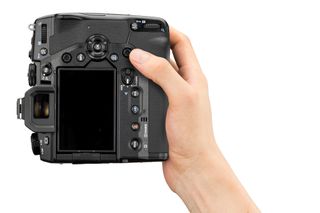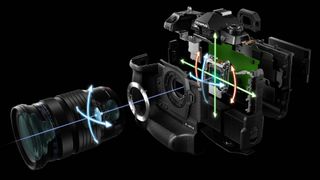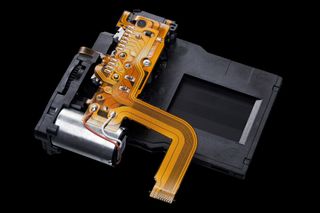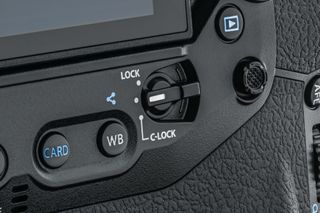Olympus OM-D E-M1X vs E-M1 Mark II: 12 key differences you need to know
How does the new Micro Four Thirds model fare against its older brother?

The Olympus OM-D E-M1X arrives with a refreshed design, some impressive tech and ambitions to edge out Canon and Nikon’s most senior full-frame DSLRs from the pro photographer’s kit bag. Olympus states quite clearly that it believes its image quality rivals that of full-frame DSLRs, and with some unique and class-leading specs alongside, it's certainly fighting hard to deliver on many other fronts.
The company’s current OM-D E-M1 Mark II has proven to be a smash, with excellent image stabilisation, fast autofocus and cracking 4K video at the top of a long list of highlights, and this new arrival is set to sit alongside it in the range. So what exactly is new? We’ve sifted through the spec sheet to dig out the 12 key differences between the two models.
- Read our hands-on Olympus OM-D E-M1X review
1. Integrated grip

The most obvious external difference between the two models is that the E-M1X has been fashioned with a built-in vertical grip, while the E-M1 Mark II has a more conventional DSLR-esque body. This was seen in a recent teaser video, although it wasn’t clear whether the grip was built into the camera itself or simply an optional extra.
This mirrors the designs of the Nikon D5 and Canon EOS-1D X Mark II, which should give you an idea of just who Olympus is targeting here. And it’s not just the first time we’re seeing this on the OM-D line, but on any mirrorless camera at all.
The main advantage of this design is that it makes capturing anything in a portrait orientation for prolonged periods of time easier. Naturally, it's equipped with its own shutter-release button, and this is complemented by a (secondary) AF joystick, an AEL/AFL control and twin command dials.
2. Second image processing engine

The E-M1 Mark II manages to do a whole lot with just a single TruePic VIII processing engine, although the E-M1X has found space for two, something we’ve seen on many previous pro-grade DSLRs.
This second engine is claimed to help improve autofocus and speed up general response, as well as shortening the camera’s start-up time. The previously seen Pro Nature mode, which captures 35 frames before you actually start shooting, also now claims to have zero lag, no doubt a further benefit of this additional processing power.
Get daily insight, inspiration and deals in your inbox
Get the hottest deals available in your inbox plus news, reviews, opinion, analysis and more from the TechRadar team.
It also allows for an evolution of the previously seen High Res Shot mode – more on that later.
3. Improved image stabilisation

One star feature of the E-M1 Mark II is its 5.5-stop image stabilisation system, which manages an even more unbelievable 6.5 stops of correction when using the M.Zuiko Digital ED 12-100 mm 1:4.0 IS Pro lens. This already ranks as one of the most capable systems of its kind, but Olympus reckons this is even more effective on the new model.
Thanks largely to a new gyro sensor, the company claims the E-M1X offers up to 7.5 stops of compensation over using a non-stabilised setup – the world’s highest correction for such a system, according to the company. That’s when using the aforementioned lens at 100mm, although if you rely on the camera-based system alone you can still achieve 7 stops, which is still mighty impressive.
4. Better battery life

That new design doesn’t just allow you to hold the camera more comfortably when capturing portrait-orientation images – it also conceals an additional battery.
The two batteries are the same BHL-1 cells used by the E-M1 Mark II, and with two on board you can capture around 870 frames on a full charge, rather than the 440 frames allowed by the E-M1 Mark II. Olympus also points out that, as the batteries are taken out together from the side of the camera, you can remove and replace these while the camera is mounted on a tripod.
It’s also possible to charge these batteries through the camera’s USB port, a process that's said to take around two hours. Battery life is one of the bugbears of mirrorless systems, so this will no doubt be welcomed by prospective purchasers, although it's worth noting that the older E-M1 Mark II can be used with the separate HLD-9 battery grip should you need extra juice.
5. Revised viewfinder

The new E-M1X also welcomes a revised viewfinder. As with the E-M1 Mark II’s viewfinder, the resolution of the LCD panel stands at 2.36million dots, but its magnification has increased, from the E-M1 Mark II’s 0.74x (in 35mm terms) to an impressive 0.83x here, which should help you to see what you’re shooting that little bit better.
The company has also reworded the optics of the viewfinder for the new model, with aspherical and high-reflective index elements for clarity, and a very respectable 120fps refresh rate and 0.005sec latency.
6. Live ND mode

ND filters are now conveniently incorporated into many high-end compact cameras and superzooms, although this isn’t something we find on interchangeable-lens models.
We don't have a physical one on either the E-M1 Mark II nor the E-M1X, but what we do have is a new digital alternative called Live ND, which blends multiple images in camera to make it appear as though a slower shutter speed has been used.
You can choose filtration between one and five stops of shutter speed, and while we don’t imagine this will convince the purist to leave their physical filters at home, it may well prove useful when its not possible (or desirable) to stop down the aperture further.
7. Upgraded Super Sonic Wave Filter

The new model appears to offer either the same 20.4MP Four Thirds sensor or a very close relation to the one inside the E-M1 Mark II, although the Super Sonic Wave Filter has changed.
This filter, which shakes off any dust and other particles to keep them away from images, has been present on Olympus cameras since the company still made DSLRs. The version on the new model still vibrates at the same 30,000 times per second rate as the one inside the E-M1 Mark II, although Olympus has applied a new coating here and claims a 10% advantage in banishing dust by comparison.
8. Shutter rated to 400,000 actuations

Pro-grade DSLRs and mirrorless cameras typically have a mechanical shutter that’s rated to around 200,000-300,000 actuations, which is how long the manufacturer expects it will last at a minimum. The older E-M1 Mark II fares well here, with its 200,000 rating being perfectly respectable, although the newer model doubles this to even more impressive 400,000.
Once again, this shutter is wrapped up in a body that's weather-sealed, although this level of protection now continues when you're using a microphone, remote and other accessories in the relevant ports.
9. Handheld High Res shot

Olympus has been one of a number of manufacturers to offer a high resolution capture option, which outputs images at a resolution way beyond what would normally be allowed by the pixel count of the sensor. As these features tend to work by capturing a number of images and blending the results into a single composite, they typically have the limitation of needing to be used in conjunction with a tripod – but Olympus has become the latest manufacturer to offer a handheld mode alongside.
From its 20.4MP sensor, this feature can output images as if they originated from a 50MP sensor, which is impressive if true. If, however, you’re happy to use the older tripod-based option that also features on E-M1 Mark II, you can bump this up to 80MP.
10. New AF settings

The 121-point all-cross-type on-chip phase detection AF sensor inside the new E-M1X, which works with a separate 121-point contrast-detect AF system, also appears to be unchanged from the older model, although a new AI-powered Intelligent Subject Detection AF option claims to detect and lock focus on different types of subjects in a way not previously possible.
The example Olympus gives is when shooting motorsports, whereby the system will recognise the type of subject and adjust focus, locking onto a driver’s helmet. AI in photography is not new, but such a feature is potentially highly useful to the kind of photographer at which the model is aimed.
Another change on the E-M1X is that the AF Target function also welcomes new 25-Point Group Target and Custom AF Target options.
11. Refined design and new C-LOCK lever

While the E-M1X is clearly an OM-D-series model to the eye, Olympus says it has refined all the external buttons and levers, not just in terms of their design but also their height and the overall layout too. This, it says, helps the user to concentrate when using the viewfinder.
The overall revamp is completed with a new C-LOCK lever, which allows the user to lock a number of buttons and dials to prevent anything being changed accidentally.
12. Built in GPS system

GPS systems are still somewhat rare on conventional cameras, with manufacturers preferring to offer an equivalent option that uses location information from a paired smartphone. This is how the E-M1 II allows for location information to be embedded in images, but the E-M1X is a little different. Not only does it contain a built-in GPS sensor, but there’s also a temperature sensor, manometer and compass on board.
Most Popular

